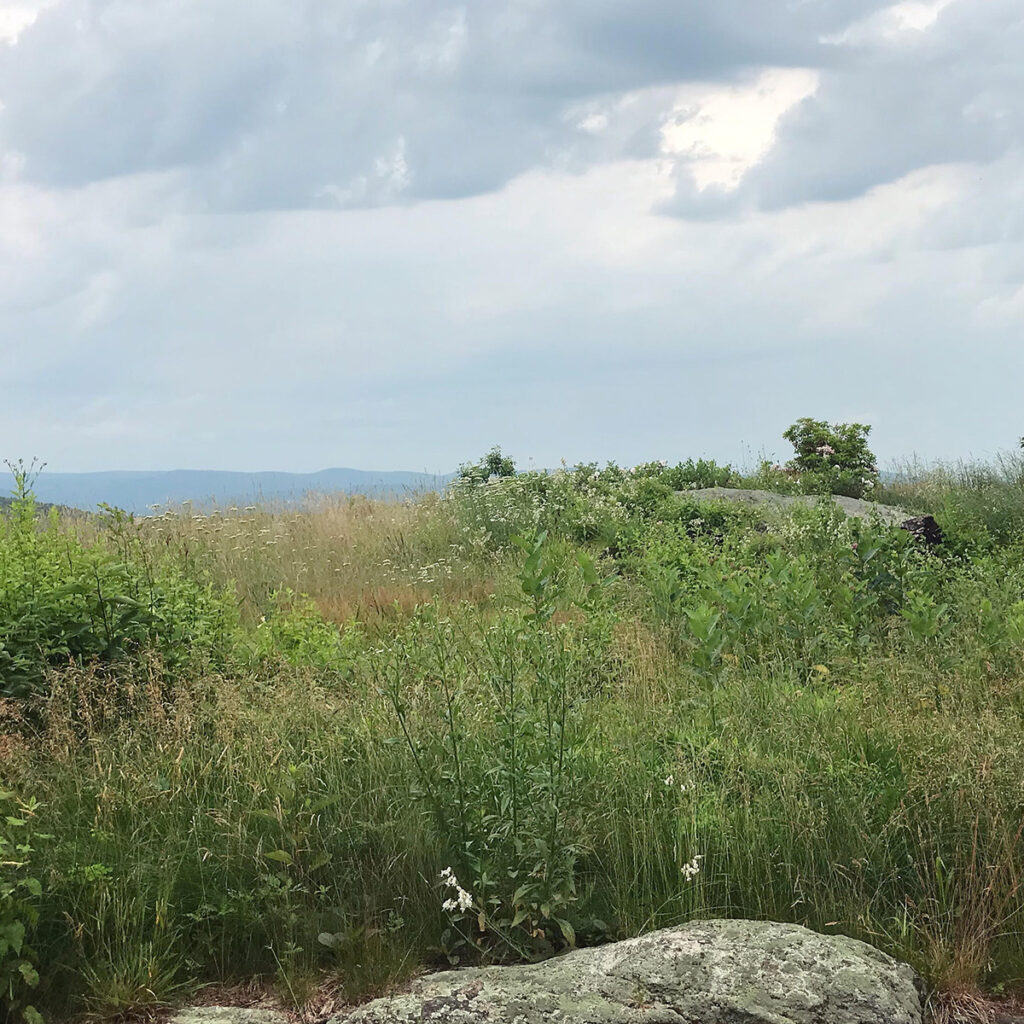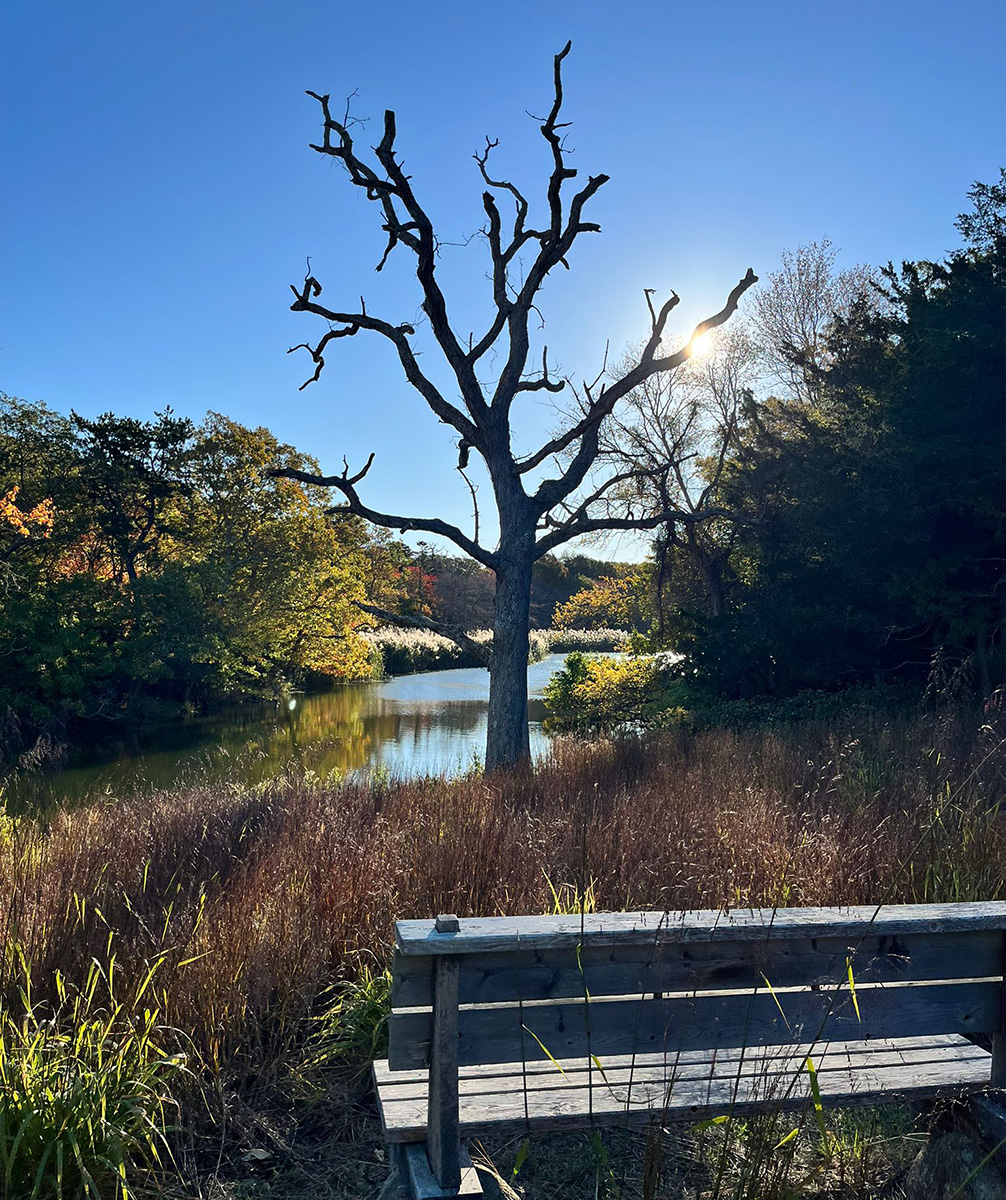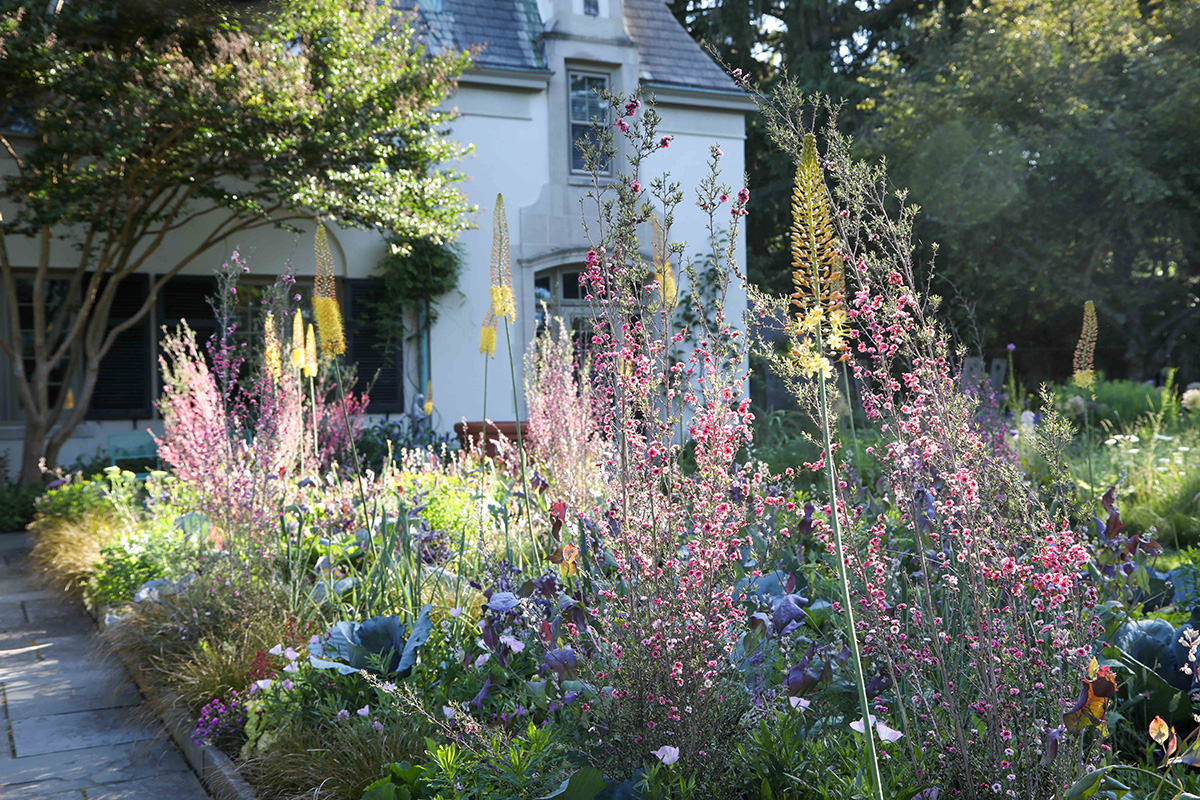
Photographs by Lindsey Taylor.
This fall, Edwina von Gal, Perfect Earth’s founder, raised a call to action to all gardeners and landscape professionals to commit to making and caring for gardens that will heal and not harm the Earth. With the realities of a biodiversity emergency and climate crisis upon us, gardeners and landscape professionals can be powerful agents of change. So, we wanted to talk with gardeners and landscape professionals to learn more about what we call their “PRFCT ground rules,” the sustainability ethos guiding their work.
Garden designer Lindsey Taylor of Lindsey Taylor Design shares the ground rules that guide her practice. Based in Garrison, NY, the landscape designer, former magazine garden editor, and author of Art in Flower creates romantic landscapes that encourage you to slow down and take it all in—to crouch down to smell the flowers in bloom, to stop and listen to the hum of insects and trill of birds, to feel the gentle brush of leaves as you stroll down a path. She talks about how she approaches a new design and how she has evolved as a designer: “I want a garden that is alive and can breathe, move, and do what it wants to do.” Here, in her own words, are her ground rules.
1. Think Big Picture.
“I start a new project by asking: Where are we? What is this land? What has it been, what does it want to be, and what makes sense for it now? What are the clients’ dreams for it? How will the garden relate to the architecture, their lifestyles, and equally important, how will it be maintained? And when I ask these questions, I’m always thinking through a lens of our environmental challenges today like climate, water, waste.
We need to design gardens that lead with progressive thinking about all these issues. We need to work with nature, not against it—and that means designing gardens that don’t rely on pesticides or synthetic fertilizers to survive and thrive. If we ask these questions as designers or homeowners upfront and think responsibly about what truly makes sense for the place, the outcome, I believe, will be gardens that don’t require chemicals to be created or maintained. “
“When I start a garden, I am always thinking about the big picture: Where are we? What are we doing? Who is this for?,” says Taylor. “For a project in the Hudson Highlands, I looked to the surrounding landscape to observe the conditions, see what was growing naturally, and notice the topography before I began designing.”

2. Engage in Real Talk with your Clients.
“I try to guide clients toward a design that makes sense for all the pressures we’re facing now, such as water, biodiversity, and climate change. I strive to execute a design that considers a client’s garden dreams but is also realistic for them to maintain. It does no one any good to create an unmanageable garden. I make sure to talk with them in depth about the long-term realities of maintenance and discuss what is viable for their budget. Of course, there are gardens for every budget.
Sometimes I jokingly remind people that taking on a garden is not the same as buying a sofa. When embarking on a new garden, unlike purchasing a sofa, you’re just beginning the spending. People need to understand that you are engaging in a long-term, meaningful relationship that will need attention and care. Guiding clients to smart choices is part of the job and the reward of being a garden designer, and that includes explaining why chemicals are unnecessary and harmful. It is critical to learn how to communicate in a useful and helpful way. It is also essential to work closely with the crews who will install and care for the gardens we design. Designers need to allocate time to share what we know and direct toward best practices.
And if possible, it’s always best to be involved in the early stages of a new build or major renovation with the client and architect. Garden designers think about things differently than architects. Don’t hire a garden designer at the end of project. We consider how the landscape and garden will merge with the architecture, the flow from indoors to out, and often offer valuable things to consider about when siting a new building. The collaboration can be very helpful for all involved and the results will usually lead to a more dynamic and healthier functioning project. “
3. Keep Learning, Keep Evolving.
“It’s essential as a designer to continue to evolve. I keep current by attending conferences, listening to podcasts with experts and forward-thinking practitioners, staying involved with public gardens, and most important, staying connected with my garden community—the growers, the makers, the designers, and the maintainers. Sharing hands-on experience is so valuable. It is an excellent way to keep pushing and educating ourselves in this field. So much is learned by doing.”

“I love using silvery hirsute foliage in my designs, like the Northeastern native mountain mint (Pycnanthemum muticum). It is a great perennial for crushing in your hand as you walk by to soak up its soothing aromatic scent. Almost shrub like, it is an excellent plant for attracting pollinators. It can be a bit of a bully so plan accordingly when using it,” says Taylor.
4. Redefine Beauty.
“Beauty is important to me as a designer, but I’ve found that my idea of what is beautiful has shifted. Gaining a deeper understanding of ecological relationships and how our approaches and ideas have real consequences has pushed that shift. When a garden is beautiful you can hear it breathing. That might seem very abstract, but I have experienced gardens that seem dead because they are so tightly controlled that they seem to be calling out for help or ones that have no sound because they’ve sprayed and have no birds or insects as a result. It’s depressing. It makes me ask: What is this is all for?
For me a garden must have movement, scent, and sound. You need to hear the birds, insects, water if you can include it, the crunching of leaves under foot, and you need to be able to brush up against the plants as you walk by. When I’m designing, I’m always thinking about all the senses. I think this leads to a healthier and a more expansive, sumptuous outcome.
Winter landscapes should be full of seed heads. Some fall maintenance is fine, cutting back some is helpful for heavy spring schedules, but leave some too. The beauty of the monochromatic winter landscape with seed heads piercing through the snow is magical. The birds and creatures will thank you.
Hardscaping material selections are also so important in a garden. Not only do we need to understand plants as designers, but we need to learn about all the materials we work with. Wood, gravel, stone—all of it—can add or take away.
And then there’s lighting . . . that’s a whole other big subject, but in short: Keep it simple and low. Do what is only essential. Let’s not to light up the sky anymore then we have. Consider the nighttime creatures and insects.”
“My garden is set within an oak and hickory forest with lots of rock outcroppings. I use this natural landscape as inspiration for my design,” says Taylor. “I practice a light touch, editing and carefully adding plants, like these pretty Sweet Everlasting flowers (Pseudognaphalium obtusifolium).”

5. Make a Plan for Water.
“Recently in the Northeast there’s either been not enough water, or too much of it, like flash floods creating havoc! It’s taught me how critical it is to consider the movement of water in designs in both landscapes and city gardens early on in the process.
Ultimately, water will go where it wants to go. We can try to control its movements, but we need to be smarter about our approaches. How can we make our projects more permeable so water can stay where it is? Can we collect it and use for the property? Can we redirect water to a swale or rain garden and provide an opportunity for another plant community and habitat?
I also try to design gardens that don’t require long-term irrigation. Making smart plant choices—right plant, right place—for your site helps with that. All plants need establishing irrigation for a couple of years, but my goal is to try to get them off after that. Sure, I’ll continue to spot water if needed in a drought or for more mature plantings, but I’m not a fan of heavy drinkers, unless they are near or in water where they will be happiest. “

Pollinator loving Aster ericoides ‘Snow Flurry’ has a tight and low form and makes a great groundcover.
6. Show Shrubs Some Love.
“There is much talk about native herbaceous perennials and their benefits for pollinators and critters, but I think shrubs could use a little more love. They are the workhorses and unsung heroes in a garden. There’s a shrub for every situation including small gardens and container gardens. They provide structure, four-season interest, habitat, shelter, and food for wildlife and us!
I love an edible shrub: Amelanchier, Aronia, blueberry, to name a few native ones. And I love a cascading shrub, like a native ninebark (Physocarpus). Lately, I’ve been using our northern native bayberry (Myrica pensylvanica). It’s semi-evergreen, provides great shelter and food for birds, flaunts gorgeous leaves and berries, and offers a wonderful robust undulating form. And it is both drought- and wet-tolerant. I’ve yet to meet a Viburnum I don’t love. And then there are all the native azaleas, Cornus, Calycanthus, Hamamelis. Oh, the list goes on and on . . . “
“I’ve always loved this American smoke tree (Cotinus obovatus) growing in a friend’s garden,” says Taylor. “It is an excellent native shrub that can grow almost to the size of a small tree if you let it. It produces smoke-like blooms in summer and has beautiful fall color.”

7. Consider Waste and Disturbances.
“When designing a new project, I look at the site to see what we can use that’s already there. I help guide construction to save and reuse as much material, such as soil, plants, stone, as possible. The old thinking of hauling everything away is just not viable anymore. I always ask: What disturbance might my design cause? How can we design to be lighter on the land? What is the plan for natural debris the design will produce? Then, I plan accordingly. Working with the existing soil is the goal. I don’t amend soils if I can help it, and instead, I choose the right plants for the soil conditions. I also try not to buy soil. A truck load of screened topsoil can still contain invasive weed seeds. Why bring that to a property? Let’s work with what we have.”

“The native mountain laurel (Kalmia latifolia) is another favorite shrub. I often find them growing in the landscapes where I’m working. Evergreen with a beautiful flower in June, they are shallow-rooted, so they’re easy to transplant if they’re growing in an area that will be worked on,” says Taylor.
8. Be Conscientious, Consume Less.
“We often fail to consider the consequences of our wants and our actions as gardeners, landscape professionals, and homeowners. Perhaps the landscape field gets a bit of a pass because we’re working with “nature”? But there’s plenty of waste and environmental consequences in the industry. We need to be much more vigilant with what we’re buying, where we’re buying it from, how and what we are planting, and how we are caring for our land.
Let’s question our old practices and consider how all of it will affect our planet and ecosystems. I’ve definitely evolved over the years as a designer. I’m more interested in working with what’s there on a property, than forcing my vision onto a place. I ask more questions, observe more carefully, and spend more time considering the outcomes then just striving for beauty.
I’m excited and hopeful that gardeners are heading in a better direction, but we need to keep questioning, learning, and working collectively—sharing information and being open to change. Nature isn’t static and gardens—and gardeners—certainly shouldn’t be either.”

By Melissa Ozawa
This is part of a series with Gardenista, which ran on December 19, 2024.









